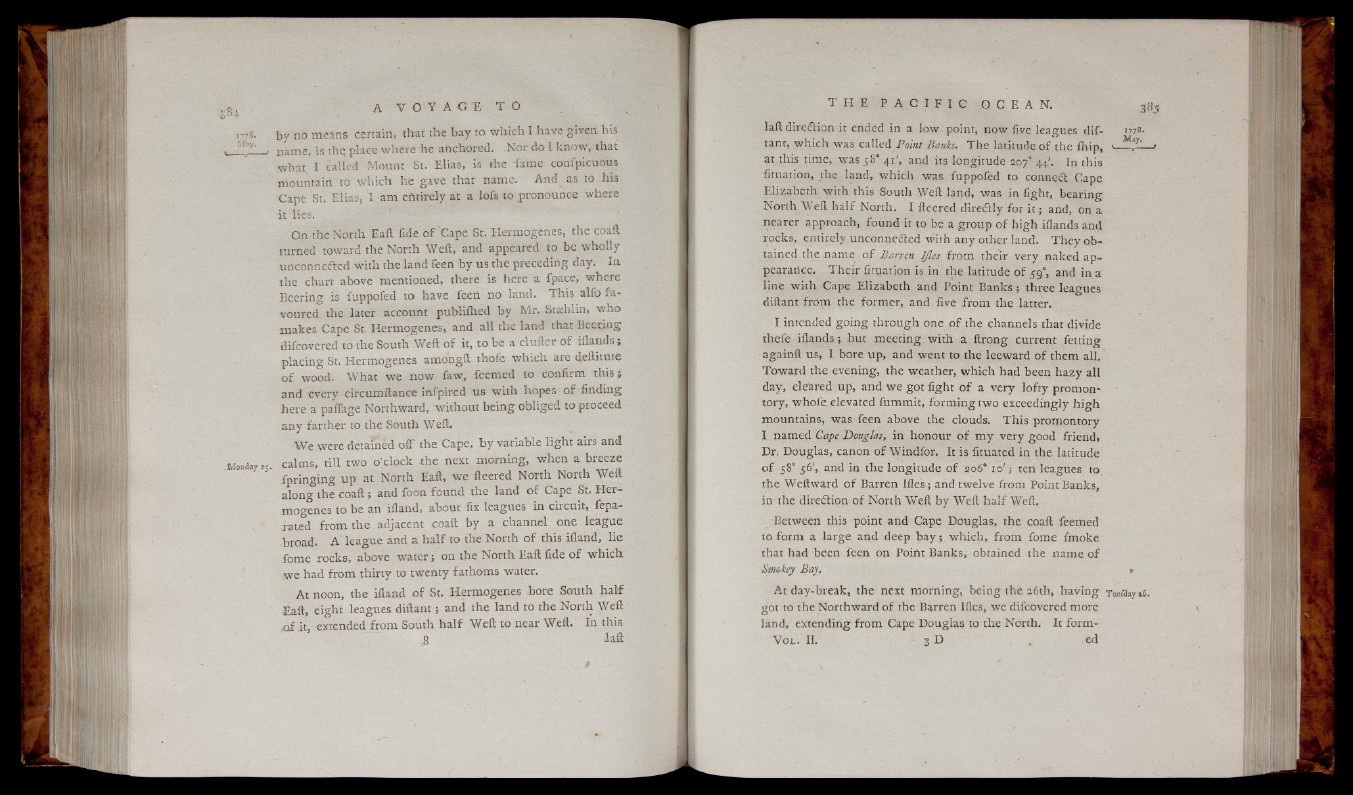
1778.
May.
.'Monday 25,
by no means certain, that the bay to which I have given his
name, is the; place where he anchored. Nor do I kn ow, that
w hat I called Mount St. Elias, is the fame confpicuous
mountain to which he gave that name. And as to his
Cape St. Elias, I am entirely at a lofs to pronounce where
it lies.
On the North Eaft M e o f Cape St. Hermogenes, the coaft
turned toward the North Weft, and appeared to be w ho lly
unconnected with the land feen b y us the preceding day. In
the chart above mentioned, there is here a fpace, where
Beering is fuppofed to have feen no land. This alfo fa voured
the later account publilhed by Mr, Staelilin, w ho
makes Cape St. Hermogenes, and all the land that Beering
difcovered to the South Weft o f it, to be a clufter o f ill arid s ;
placin g St. Hermogenes amongft thofe w h ich are deftitute
o f wood. What we now faw, feemed to confirm th is ;
and every circumftance infpired us w ith hopes of-finding
here a paffage Northward, without being obliged to proceed
an y farther to the South Weft.
W e were detained o ff the Cape, b y variable lig h t airs and
calms, till two o’clock the next morning, when a breeze
fpring ing u p at North Eaft, we fleered North North Weft
a long the co a ft; and foon found the land o f Cape St. Her—
mogenes to be an ifland, about fix leagues in circuit, fepa-
rated from the adjacent coaft b y a channel one lea gu e
broad. A lea gu e and a h a lf to the North o f this ifland, lie
fome rocks, above w a te r ; o n the North Eaft fide o f w h ich
w e had from thirty to twenty fathoms water.
At noon, the ifland o f St. Hermogenes bore South h a lf
Eaft, e ight leagues d iftan t; and the land to the North Weft
¡of it, extended from South h a lf Weft to near Weft. In this
s daft
laft direction it ended in a low point, now five leagues dif- >778.
tant, which was called Point Banks. T he latitude o f the fliip, ■ »
at this time, was 58* 41', and its longitude 207° 44'. In this
fituation, the land, which was fuppofed to connect Cape
Elizabeth with this South Weft land, was in fight, bearing
North Weft h a lf North, I fleered direCtly for i t ; and, on a
nearer approach, found it to be a group o f high iflands and
rocks, entirely unconnected with any other land. T h e y obtained
the name o f Barren Ifles from their very naked appearance.
The ir fituation is in the latitude o f 59°, and in a
line w ith Cape Elizabeth and Point Banks ; three leagues
diftant from the former, and five from the latter.
I intended go in g throu gh one o f the channels that divide
thefe iflands ; but meeting with a ftrong current fetting
againft us, I bore up, and went to the leeward o f them all.
Toward the evening, the weather, which had been h a zy all
day, cle'ared up, and we got fight o f a v e ry lofty promontory,
whofe elevated fummit, fo rmin g two exceedingly h ig h
mountains, was feen above the clouds. T h is promontory
I named Cape Douglas, in honour o f m y ve ry good friend,
Dr. Douglas, canon o f Windfor. It is fituated in the latitude
o f 58° 56', and in the longitude o f ao6“ 10'; ten leagues to
the Weftward o f Barren Ifles; and twelve from Point Banks,
in the direction o f North Weft b y Weft h a lf Weft.
Between this point and Cape Douglas, the coaft feemed
to form a large and deep b a y ;. which, from fome fmoke
that had been feen on Point Banks, obtained the name o f
Smokey Bay. »
At day-break, the next morning, being the 26th, having Tnefday is.
got to the Northward o f the Barren Ifles, we difcovered more
land, extending from Cape Douglas to the North. It form-
Vox,. II. 3 D . ,ed